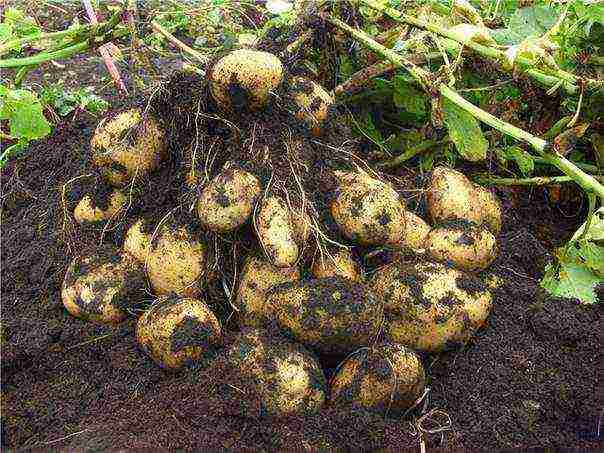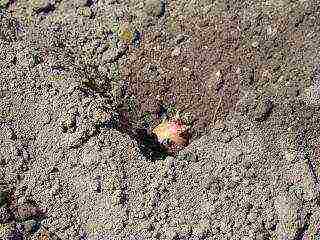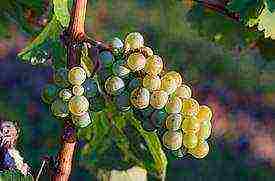Content
- 0.1 How to get a bucket of potatoes from a bush!
- 0.2
- 0.3 Potato seed material
- 0.4 Where to get potato seed material?
- 0.5 Seed preparation
- 0.6 Renewal + reproduction of potatoes
- 0.7 Preparing potato seeds before planting
- 0.8
- 0.9 Favorable conditions for the development of potatoes
- 0.10 My passion for organic farming
- 0.11 The essence of my potato growing technology
- 1 How to plant sprouted tubers
- 2 What's on the field? ..
- 3 My methods ...
- 4 ... and results
How to get a bucket of potatoes from a bush!
Potatoes are our second bread!
If you have only 5 acres, then it is important to learn how to grow more than 100 buckets from 30 bushes.
Potato harvest depends 40% - from seed, 60% - from the conditions of development!

How do you used to plant potatoes?
Usually, most gardeners do this:
Potatoes are dug up in the fall. Choose medium or small for landing, just fold into one pile.
In the spring they took out, plowed or dug up the earth. They go, digging holes and throw in one, at best sprouted, potatoes, they dig in. Then they weeded it and spud it a couple of times. Everything!
They planted one potato - two dug up!
Then they still wonder: Well, how is it? Hilling, weeding, watered ...
Those, who switched to natural farming, of course they don't do that anymore. And you will learn how to grow potatoes right now! ...
What potatoes like
Potatoes do not like poor and dense soil! It only grows on loose and fluffy soil at a certain temperature!
Which potato variety should you choose?
"Every man to his own taste!"
Someone loves friable potatoes, someone early (it is not friable - there is little starch), mashed potatoes, fried, for soup, so that it is tasty ...
Variety requirements:
- Gives a stable harvest in our conditions
- Meets our requirements
- Have different ripening periods
Potatoes need a minimum of 50 days from planting to harvest. You can speed up this process by growing potatoes in seedlings. So you cheat the frosts and get the harvest earlier.
Potato seed material
You can take the first material from a test tube - mini tubers, it's not cheap, but for 7 years you don't know any problems:
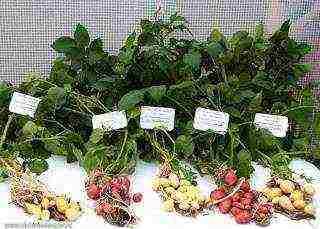
- Super-super elite (retains its qualities for 7 years)
- Superelite (6 years old)
- Elite (5 years old)
- First reproduction (4 years)
- Second reproduction (3 years)
This is the elite:
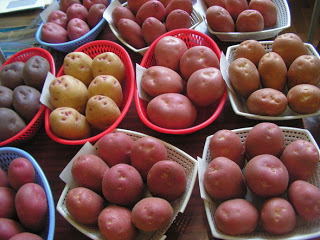
And after the second reproduction, the potato loses some of its qualities, accumulates diseases, becomes less productive and needs to be renewed.
You can buy a test tube again and not have any problems for another 7 years.
Where to get potato seed material?
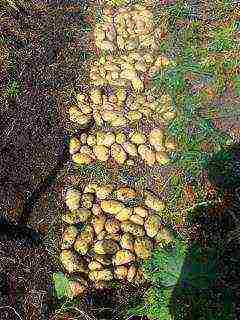
Buy on the marketshe may be worse than in her cellar
Buy in garden centers, shops
Grow from seed
Prepare by yourself
we select the best bushes, each bush is a separate heap, we take the whole
The best indicator of good bushes is
Colorado beetle ! Where he sits - these are weak potatoes, they are tired, they will not give good offspring, they cannot be taken for seeds.
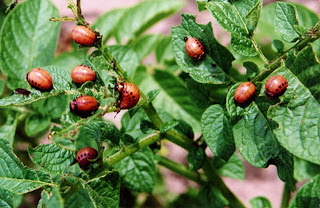
Mark these bushes so as not to take from them! There you have to either improve the land, or improve the material ...
How do I do:
I dig up the whole bush - I do not remove the large one separately, the middle one separately ... I leave it next to the hole where I dug it, I dig the whole row and start looking.
Firstlyso that the tops themselves are not affected by various diseases.
Second, so that the very appearance of the potato corresponds to the shape: if it should be oval, then it should be oval, not round ... So that it would not be gnarled, sick.
Third, number of tubers.If there are 24 tubers in the bush on average, and in some 40, but small ones, then I will take the one with 24 pieces.
If there is a large potato in this bush, then I will take a large one for seeds - I will not select the smallest one, because then I will cut the large one better.
Seed preparation
You can prepare in different ways:
can be cut - and I'll show you the difference - what comes out of small and what comes out of large
can be grown from seed - in the first year, both planting material and food are obtained. But I do not advise from seeds, because they usually sell varieties of 20 potatoes by seeds and mostly Dutch varieties - not very tasty ... Fans of something new can experiment ...
Renewal + reproduction of potatoes
Any sprout with two buds gives roots.
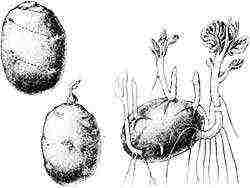
Potatoes multiply very quickly vegetatively. Let's take a tuber, if you have one, and you need to get a lot of seed material from it.
They dug him in with earth - he will give a sprout. You carefully twist this sprout and transplant it into a glass.
At this place, a sprout grows again, and so a tuber from one place can give up to 10 sprouts. They will be getting smaller, but they will be.
You create moist conditions for these sprouts and they actively germinate. These will be separate independent plants. Imagine how many seedlings from one potato you can plant? - A lot of.
You plant a 20 cm high cut on the garden bed.
Usually we get potatoes for sprouting, but have you noticed that not all eyes wake up? Sometimes two or three eyes appear and that's all, but potatoes can do more.
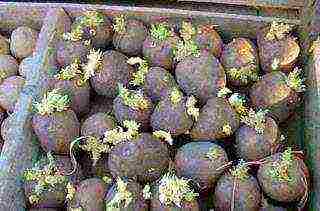
We stimulate the appearance of eyes:
Make transverse cuts along the ring about 1-1.5 cm.

Be sure to dip the knife into the brilliant green after each potato, so as not to bring any diseases.
Or under each eye we make a sickle-shaped incision.
From my own experience, if you plant a large potato, then it will develop slowly. Why would she move on to her own roots?
There may be 3-4-5-6 shoots in the bush, the nutrition in this potato is completely sufficient and it almost does not develop the root system.
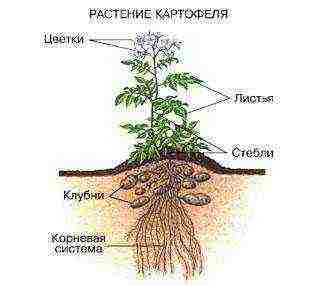
What for? She has enough nutrition from the mother's tuber ... It has enough nutrients to live quietly.
It looks something like this, if you feed your children on your retirement, then they can sit next to you for up to 40 years and not work, live like this all their lives.
Potatoes do the same - everything in nature is the same.
What are you doing to prevent this from happening?
You take it and cut it into pieces.
Here are the diagrams of how you can cut potatoes correctly.

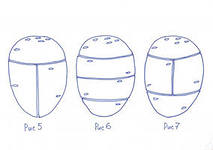
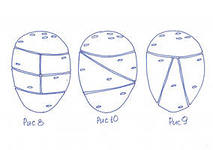 And it turns out like this:
And it turns out like this:

The smaller the potato is by one or two eyes, the larger the potatoes are.
I take off an 8-liter harvest bucket from one such piece.
This does not mean that if you plant a small change that has already degenerated, you will get a good and large potato. No! It's about good seed!
What the potato does in this case (when we cut it into small pieces) is that it goes over to its own roots. That is, it develops a good root system.
We divide the potatoes so that there are at least three shoots on the piece!
It is not advisable to throw freshly cut potatoes, because there the open cut is a starchy environment. Possible development of pathogens that can develop in this starch.
The potatoes will simply rot or your entire bush will be infected. What need to do?
Or keep it for 3 - 4 days under the open sky, it dries up
Or anoint with ash (ash, charcoal - they contribute to disinfection)
Or dipped in cement, a thin crust then disappears and that's it.
Preparing potato seeds before planting
1.5 months before planting stack potatoes for sprouting in boxes, jars (if the apartment is very hot).
We spray stimulant to wake up the kidneys
We have in a bright room, but not in the sun
10 days before boarding shelter dark impervious fabric
It rises on the 5th - 7th day.
Why do we cover with a cloth?
He will think that his already planted and processes that promote germination will begin in it! And after landing, he will quickly rise.
You can put together such a convenient rack, as some good people came up with, for those who sprout a lot ...

It is very convenient, you can easily rearrange the boxes. Place away from windows and sunlight. When exposed to sunlight, the sprouts become coarse.
This is how we cover it with a covering material so that the potatoes do not flabby:

And then wrap it up with a dark cloth as well.
Favorable conditions for the development of potatoes
- Fertile loose soil
- Sufficient moisture
- Optimum temperature
In infertile soil, you develop a wireworm, he loves poor soil.
At temperatures above 26 degrees, there will be no harvest. Potatoes do not grow in hot soil.
Therefore, you must provide these conditions.
Natural farming methods make the soil fertile.
Fertile soil is made by organic matter - BIOHUMUS.
Therefore, everything that you took from there with tons of potatoes and tops - you must return there. Nothing makes the soil fertile like
organic
!
Dug a hole - added two buckets of organic! Only in this organic matter will potatoes grow.
When you plant 30 potato bushes and remove a bucket from each bush, you will have free time, you will retain strength, then the children will not say to you: Yes, I better buy you a bag of potatoes, do not suffer! ... just leave me alone ...
- You need to plant, then weed, then huddle, then collect the Colorado potato beetle, and then dig three more piles, and in a pile - three things ... When we have our own business! - I'd rather buy ...
And when you grow 30 or 40 bushes for pleasure ...
And when you are not digging, just pulling the tops - get the bucket ...
And when all the neighbors are hanging on the fence, watching this miracle ...
Or they will help you dig with you to count the number ...
Every now and then the children will be there!
Different types of organic matter - potato harvest
Conducted an experiment:
- Control-land - potatoes dug up 750 gr
- Biohumus - 1050 gr
- Compost - 1100 gr
- Humus - 718 gr
The most favorable thing is compost!
Organics must be rotted. There is also a unique way
growing potatoes under straw
, I really like it - generally simple and effective! Try it yourself.
In general, often novice gardeners ask where to start? I'll tell you here that already in the first year you can grow a good harvest of potatoes right on the sod !!! You will not need large physical costs, you will find out in more detail by watching a short video.
We plant potatoes when two leaves the size of a ruble coin have blossomed on a birch tree!
Planting potatoes
We choose a comfortable fit, focusing on the number of shoots per hole, as shown in the figure.
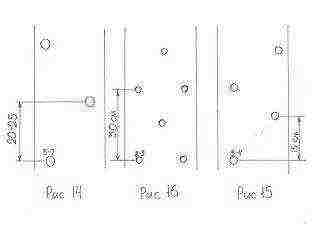
5 - 8 cm on heavy soils
8 - 12 cm on light soils
Sprouts down, but so as not to break them. The sprout should be firmly pressed to the ground. The shoot will sprout with a bend, which means it will be longer - more tubers.
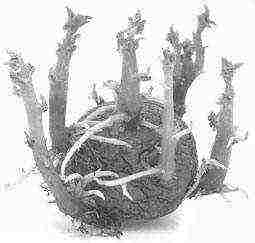
You can also plant sprouts up. But the white trunk under the ground is a nutritious shoot, and the longer it is, the better for the tubers.
Everyone is used to counting potato bush one plant. In fact, when one trunk appears, it has its own roots and a bush - it is a collection of many plants.
That is, each stem potatoes - it is a separate plant. Have you noticed, probably, when there are 10 stems on a bush, and you dig up, there are 5-7 potatoes?
And there are 30!
The very first sprout that appears above the ground captures the most nutrition - it is strong and it can accumulate 8-10 tubers. Here are the first few - they give the most yield.
And the last trunks are, in fact, weeds. They take food, but they do not have enough strength for the fruits, at best, peas.
Everyone knows what rachid is? If a child is not given full nutrition in childhood, then rachid develops. It's the same with animals.
The same thing happens in plants. If young shoots grow in thickening, they are programmed.
These last shoots in potatoes are initially programmed to ensure that they cannot produce a crop, they no longer plant tubers and do not try to grow something.
According to the logic of plants - they do not want to breed poverty!
When cutting potatoes when planting, each stem lays in itself from 10 to 30 pieces tubers. His structure is different from the one that was planted with a whole potato.
This is how we put the sprouts in the hole, so that they are at a distance from each other, so that later they do not shade themselves longer.
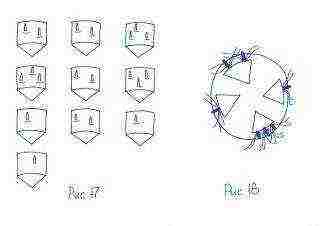
You can also place seven sprouts in a hole, but turning them in different directions of the hole.
I do this: I loosen the soil by 5-7 cm, make a hole with my hand, lay the sprouts, next I make a hole again and put the earth from it in the previous hole with sprouts, etc. And that's it!
This ends the landing! Then I am required to mulch the soil and harvest in the fall!
I do not huddle, because there is no need for it, I do not water, the mulch retains moisture, there is no Colorado potato beetle, because the potatoes are strong and healthy !!!
When the potatoes are harvested, you will need to harvest correctly
potatoes for storage
! I wish you also enjoy growing potatoes!
Did you like the article? Share with your friends!
In mid-July, local television crews came to the site, accompanied by two agricultural scientists, to see the benefits of the organic farming system on site. I got the Borodyansky pink variety. Weighed the tubers, on average it turned out 3.2 kg in the "nest", that is, about 1200 kg per hundred square meters. (When harvested in early September, this variety gave 1900 kg per one hundred square meters).
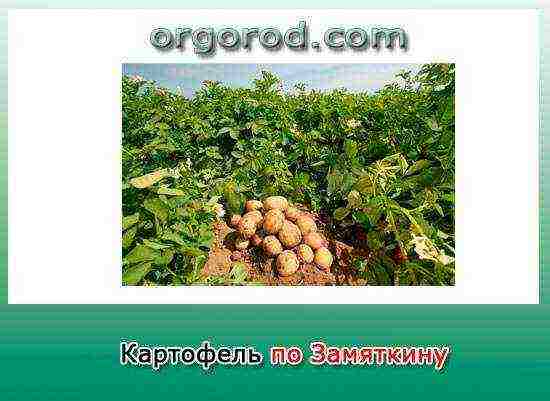
What especially amazed the guests was that they easily stuck a peg for a tomato garter with one hand into any 25-30 cm garden bed.
My passion for organic farming
I have been studying the problems of natural farming since the 60s of the last century, however, I also became wary when 12 years ago I learned that in the neighboring Minusinsk region, at the variety plot, some varieties are being obtained for some varieties of 120 tons per hectare. Before that, the planting of potatoes with a yield of more than 50 tons per hectare had not been seen, although in the literature I met reports about much larger ones.
I touched a heart, and decided to try to achieve a similar yield myself, but not in traditional technology, but in the system of organic farming. By that time, I had experience in this matter and had already become a staunch supporter of the biologization of agriculture. In the fourth year, I received a harvest of 1200 kg per hundred square meters. And last season (2004), the Lina variety, bred by the Siberian Research Institute of Plant Production and Breeding, gave an average of 5.4 kg per bush, or more than 2 tons per hundred square meters (if we count the planting density - 4 nests per 1 m2). Other varieties "ugly" on 1200-1900 kg per one hundred square meters. Already dozens of farmers and summer residents in the region are successfully mastering this system.
Of course, the technology of growing vegetables in the beds and in the field is not the same thing. However, thanks to it, the main thing comes to light - the potential of the variety, manifested in favorable conditions. This ability is most pronounced in root and tuberous plants. I made sure that the possibilities of potato varieties are used at best by 10%. Other facts also speak of this.
The essence of my potato growing technology
I lay seed tubers for germination in room conditions in December-January in translucent 10-kilogram sugar bags. Compared with the traditional method of germination on racks and in plastic bags. My method turned out to be better, since very strong sprouts are formed, and the tubers do not lose moisture.
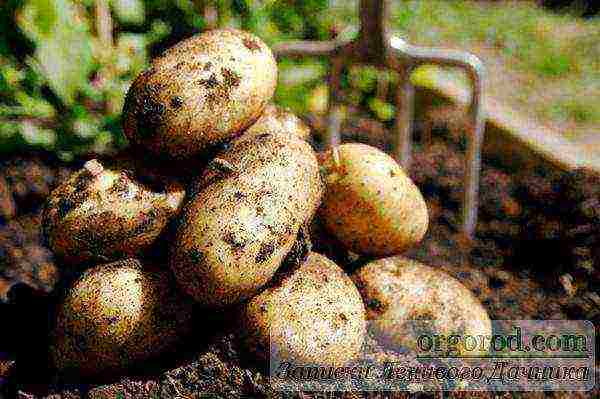
Like all other crops, I only grow potatoes in the beds. Their width is no more than 90-100 cm (there are already), the distance between the ridges is 120-140 cm. I plant early, as soon as the soil stops smearing, without waiting for it to warm up to 7-8 ° C.Planting dates usually coincide with early cereals and onion seedlings.
More than once I have heard objections: in cold soil the tubers will "harden". But why don't they “tan” all winter at much lower temperatures? And planting with sniper accuracy within the recommended temperature limits is almost impossible: the weather is unstable in spring, the soil temperature is also "dancing". And a delay in planting even for a day or two in our conditions is fraught with loss of yield. The proposal to focus on the blooming of birch leaves has long confused me: there are many birches near my site, but they “sweep” the leaf with a difference of 4-5 days, since they belong to different species. Which birch to believe?
Tubers are waiting in the wings, albeit in an insufficiently heated soil, but this hardens them. The risk of Rhizoctonia disease on healthy tubers in healthy soil is very small. I also did not notice the sprouting of tubers.
How to plant sprouted tubers
In abundantly flowering varieties (Alena, etc.) I remove the buds, which also gives an increase in yield (up to 25%). I start harvesting when the lower leaves turn yellow and the foliage stops growing, but the main sign by which I start harvesting is the formation of a dense peel.
I must conduct a clan selection every year. As a result, under the conditions of organic farming, varieties, especially domestic breeding, do not age for 10-15 years. Yes, seed growers forgive me, but dozens of potato varieties are known that do not degenerate with constant selection for 100 years or more.
Immediately after harvesting, I sow the potato beds with siderates. Seed tubers from the best "nests" are mine and I plant under a canopy already in the fall. There is practically no waste during storage of such tubers.
I want to emphasize that all the features of agricultural technology are "tied" to the conditions of a particular site. There is not and cannot be the same technology even in neighboring fields, not to mention the soil and climatic zones. Therefore, I do not suggest that someone copy my experience, it is more important to understand the idea, meaning, and the rest is a matter of creativity.
On my site, the soil is sandy loam, in its original form, low-humus (2-3%), low-power chernozem with an arable layer of 18-20 cm. Now there is twice as much humus, the plow sole has disappeared. The growing season in our climatic zone is 95-105 days. Precipitation falls on average 300 mm per year (according to long-term average data), but the last 3-4 years the humidity has slightly increased, which creates preconditions for the development of fungal diseases.
For the second decade now I have not plowed and have not dug up the soil, have not fertilized. But the fruit change in the beds is very densely saturated with green manure, I must mulch the soil with cut grass. They often object: green manures cannot make up for the removal of substances from the crop. It depends on what siderates. Jerusalem artichoke, mallow, corn, sunflower, Japanese paiza, sugar sorghum, amaranth and others give even in our harsh conditions up to 1.2 tons of green mass per hundred square meters, which is equivalent to the introduction of the same amount of bedding manure. Such a yield of organic matter is enough for a 3-4-year fruit change. But this is not the main role of the siderates. The powerful root system of sainfoin, sweet clover and other green manure crops makes the soil porous to a depth of 6-8 m.But it is in this system of pores that all life processes go on vigorously: soil animals multiply, precipitation is distributed, parent rock and organic matter are decomposed by microorganisms, worms and other soil inhabitants and become nutrients available to plants.
I don't bury the siderata, but prune it before flowering just below the root collar or tillering node with a sharp shovel or flat cutter and leave it in the beds as mulch. The rest of the work is excellently performed by worms and other macro- and microflora and fauna. It is worth digging up or compacting the soil at least once, that is, destroying, destroying the pores - and this whole wonderful complex stops working. Then we are forced to plow, dig, water, fertilize, etc.
My area from snow to snow is covered with living vegetation or mulch for all cases of liberation from the main culture of even the smallest piece of land. All paths under the lawn (white clover, red bent, etc.). In addition to the already mentioned siderates, I use winter rye, spring rape, beans, spring rape, white mustard, oil radish, phacelia, Greek fenugreek and others.
He refused from the classical crop rotation schemes - they do not fit into the conditions of the backyard economy. However, fruit change is mandatory, and for each bed it is different, which allows you to take into account the microrelief, shading, the proximity of other plants, etc.
I. ZAMYATKIN, member of the People's Experience community, Michurinets club, Shushenskoye settlement, Krasnoyarsk Territory.
Article source
Read related articles:
My "secret" of growing potatoes
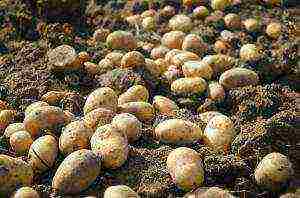 My husband and I, he is also a biologist, have long abandoned the treatment of the garden with pesticides, and only the Colorado potato beetle haunts us. It would be possible to collect beetles by hand, but there are a lot of them flying into our tiny plot, because our dacha - a house in the village - is located among huge tracts of potatoes. Neighbors process planting of potatoes from the Colorado potato beetle up to five times! Eating potatoes after that is pretty risky. But they not only eat it themselves, but also sell it to procurers, feed the cattle, and, in addition, donate milk from cows to a dairy plant! Yes, their gardens look beautiful, nowhere is a leaf damaged by a beetle or a larva. My potato garden looks worse, but we only process it once!
My husband and I, he is also a biologist, have long abandoned the treatment of the garden with pesticides, and only the Colorado potato beetle haunts us. It would be possible to collect beetles by hand, but there are a lot of them flying into our tiny plot, because our dacha - a house in the village - is located among huge tracts of potatoes. Neighbors process planting of potatoes from the Colorado potato beetle up to five times! Eating potatoes after that is pretty risky. But they not only eat it themselves, but also sell it to procurers, feed the cattle, and, in addition, donate milk from cows to a dairy plant! Yes, their gardens look beautiful, nowhere is a leaf damaged by a beetle or a larva. My potato garden looks worse, but we only process it once!
When potato shoots appear, and the beetles get out to the surface after wintering, I I spread potato peelings in the garden, collect and destroy the beetles that gather on them. I do the same when the potatoes are already harvested, and the hungry horde pounces on the tomatoes.
Potatoes in our gardens are an alien plant that came to us not so long ago. The stranger and his pest - the Colorado potato beetle. He came to us even later, in the middle of the last century. Geologically, this is a moment! Therefore, our entomophages have not yet included it in their diet, and those that were brought from America turned out to be few. Guinea fowl eat the Colorado potato beetle, if they are taught to do this from childhood. But guinea fowls, especially trained ones, are not often found in our villages and summer cottages.
There is one more pretty efficient method getting rid of the Colorado potato beetle. It is necessary to raise the seed potatoes from the storage in advance, put them in a warm place. The potato sprouts must grow before planting. Then, by the time the beetles lay their eggs, its leaves and stems will be coarse, and the Colorado beetles will go to look for more tasty food for themselves.
But now the potatoes have already raised their stalks, unfolded the foliage, and the beetles have begun to lay their eggs. Sometimes I collect striped gluttons, destroy the clutches. However, in our conditions, this does not really help, because they massively fly over and move to the garden from neighboring areas. The first larvae emerge from the eggs, then there are more and more of them, but I, holding in my fist the desire to rush after the sprayer, wait. The Colorado potato beetle larvae, which emerged first, have already grown a little - their black abdomens have turned red. Now you need to very carefully monitor the plantation, and when such small red larvae become the majority, process the potatoes. Several years ago, we began to use the drug at our site. Aktofitand he did an excellent job. Of course, sometimes the egg-laying in the Colorado potato beetle is very stretched, the larvae that emerged first can already strongly devour potato bushes by this time. However, for plants, if they are strong and healthy, such a shake-up is not terrible - as soon as the treatment removes the pest, they will very quickly build up a green mass.
By the time the young beetles emerge from the pupae, the potato stems and leaves have time to coarsen, so the larvae of the second generation are not very scary to them.At this time, we sometimes collect beetles, but we are no longer particularly worried about the fate of the potatoes.
Here is my little "secret".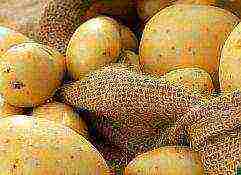
We plant not a lot of potatoes - a little more than a hundred square meters, but this is enough for our family, because we get a consistently good harvest, about 5-6 bags for food and 1.5 bags of seed potatoes, we give a bag of small potatoes to our neighbors. We cultivate varieties that are not very productive, but with excellent taste. We fertilize with compost.
Sometimes I process potatoes Mikosan from late blight. At first, there were quite a few wireworm larvae on the site, but mustard leaves scattered - we love it very much in salads, and the excess goes to green fertilizers - and now there are few larvae. Moles, ground beetles and other predatory beetles and their larvae eat up harmful larvae. We try to limit the spread of wheatgrass, the stems of which are so fond of wireworms. Sometimes on the site the potato tubers are eaten up by the larvae of the May beetle and the scoop, the bear arranged its underground nests here, however, moles deal with these problems.
Z.L. Berest
Cand. biol. Science Club OZ, Kiev
25 years ago, our family issued a lease
hectare of land 15 km from the house ... And all these years he has been helping us to survive in any disasters in society.
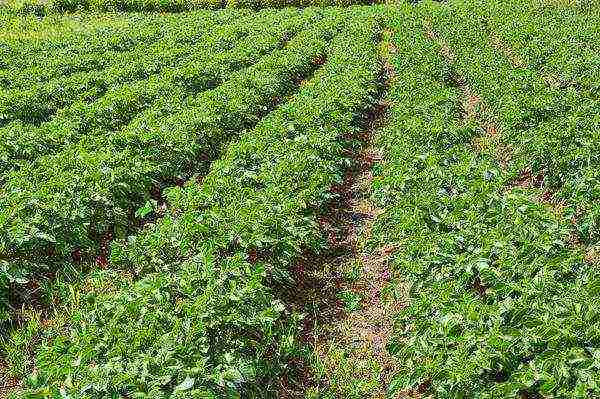
How to revive killed soil. Potato field without tractor and plow
- Grandpa! Have storks already arrived in our potato field? - the grandchildren ask at the beginning of May.
- They have been arriving at this time for 25 years already. Get ready - let's go, see how they catch frogs, arrange a photo hunt.
- That's right, our potato field is the most beautiful from a height. The stork is a smart bird, it loves beauty! - adds the grandmother.
When we were driving to the field, a flock of storks overtook us:

Storks
When we got to our grounds, the birds were already there.
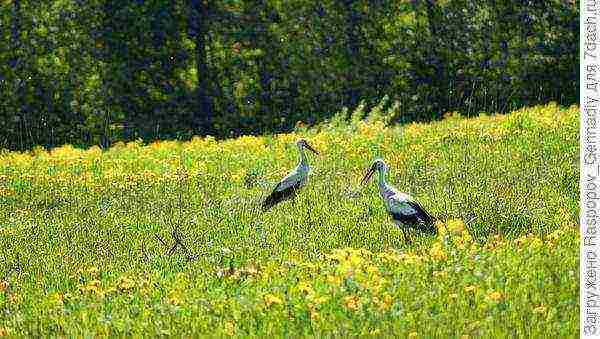
Storks welcome us
What's on the field? ..
In our family, no one goes to the store - we grow potatoes and vegetables ourselves. For the last 5 years we have not been planting anything for the market - only for ourselves, children and grandchildren. All live separately, but within walking distance. On weekends, 11 people gather at the table.
Tomatoes, cucumbers, greens grow near the house, and mostly potatoes in the field (40% of the area). There is a lot of fodder beets (about 25%), and in the rest of the area there is cabbage (including cauliflower and broccoli), carrots, red beets, pumpkins and zucchini, watermelons and melons, corn and sunflowers.
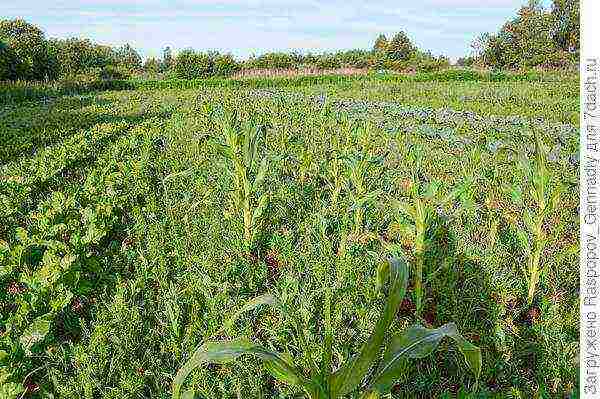
Beets, corn, cabbage Growing potatoes and vegetables over a large area is very hard work. With mechanization, you will kill the soil, without equipment, you will ruin your health ...
We strictly observe the crop rotation: potatoes return to their old place after 1.5 years, other vegetables - after 5 years. Therefore, we do not have keels on cabbage and nematodes on potatoes. In addition, I constantly purchase high reproductive potato seeds and cabbage seeds from reliable companies.
I will tell you how, without using a shovel and a plow, I managed to revive the collective farm soil killed by tractors and "chemistry", to increase the humus content in it, and to increase the biodiversity of soil living creatures.
My methods ...
The first 15 years I plowed the field with a tractor and a plow, and even with regular application of manure, the land degraded. And only in the last ten years have I been able to solve two problems that have not been solved by large farms:
- How to kill weeds and not kill soil biota?
- How to preserve and increase soil living creatures with high yields?
Gradually, he worked out effective agricultural techniques.
Weed-free field
In the fall - late Indian summer in October - I walk through the field with a hand sprayer, find rare clumps of green wheatgrass and destroy it with Roundup. The absence of perennial rhizome weeds allows me to loosen all the soil in the spring with a rotary cultivator to a depth of no more than 5 cm without bed turnover... The entire soil is covered with litter from dried annual weeds and potato tops, therefore, during surface cultivation, it is mixed with their remains, enriched with lignin.
This year, the soil at the site of the potato furrows was so loose that a 6 kg cultivator was enough for me. Arriving, we saw our spring field without weeds. The aisles are covered with felt of last year's grass, and in the furrows after the harvested vegetables there is soft structural soil, no plowing is necessary.
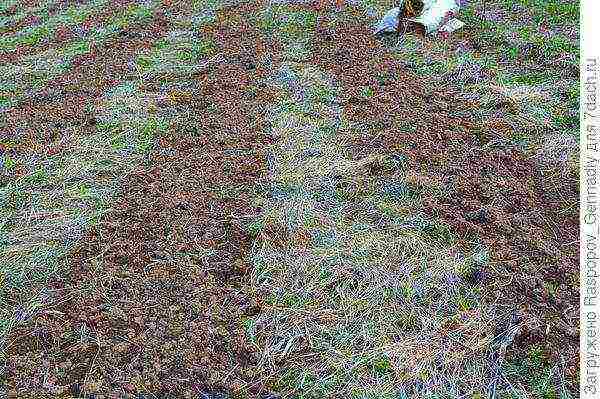
Spring field
Organic and mineral water
It is difficult for me to take out a lot of organic matter on a large field. Usually in autumn we export up to 3-5 tons of bedding manure in bags. We scatter only under cabbage and potatoes. It turns out on average per year no more than 1-2 kg per 1 sq. m of the whole area (cabbage gets 5 kg, potatoes - 2 kg per season).
Since we do not have empty plots of land, everything is overgrown with annual weeds and crops. This gives up to a ton of organic matter per hundred square meters (10 kg per 1 sq. M.) - more than enough for feeding soil animals.
And since I don’t scatter mineral water and don’t kill the earth with a plow, the mineralization of organic matter is slow, lignin turns into long-playing humus.
How to do without a plow?
How do we manage to plant the entire field (before 100, now 35 acres) with our hands in 10 days in May, together with my wife? Very simple.
There is light motor cultivatorwith which I make long double furrows (distance between furrows - 40 cm, row spacing - 100 cm). We plant potatoes, cabbage seedlings, beets and other vegetables in the furrows.
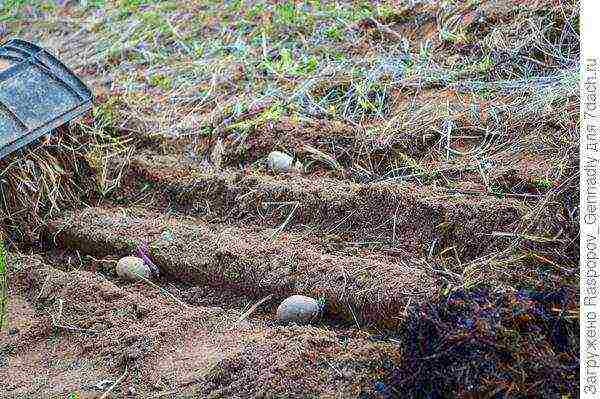
We plant potatoes in the furrows ... We constantly mulch cabbage with manure. Sprinkle potatoes from above with old compost from bags; sometimes I add locally long-playing "Kemira" potato. Then, turning the cultivator knives over, we quickly cover all this with soil.
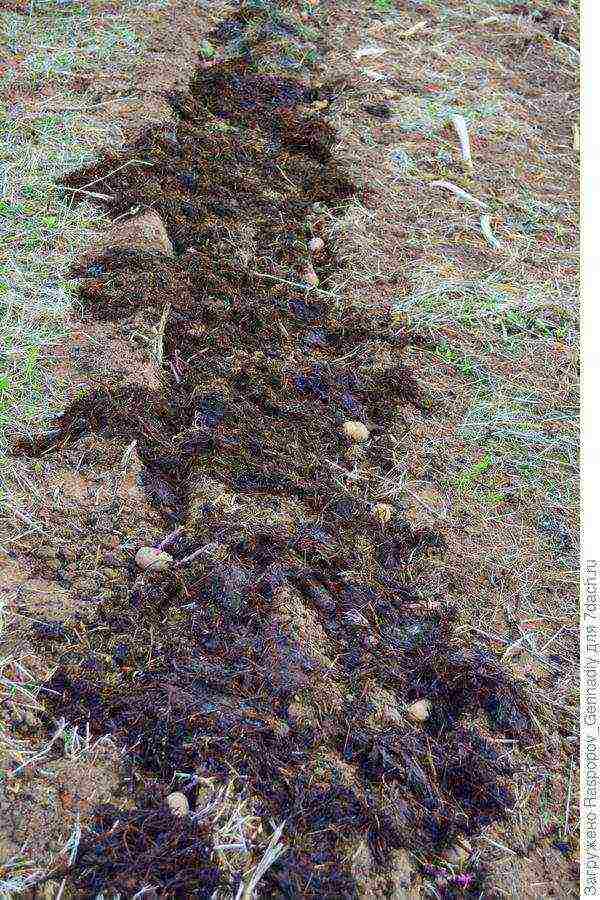
Sprinkle the potatoes with old compost from bags So I cut holes 5 cm deep, my grandchildren lay out the potatoes, my wife and daughter sprinkle the furrows with manure that lay in bags for the winter - it remains to cover the furrows with a layer of soil about 5 cm with a hoe.
We work in June
flat cutter
on the shoots of annual weeds (of course, only in the furrows) and hilling plantings
cultivator
... We pass the line spacing a couple of times with a fishing line
trimmer
- 2 hours of work on all 35 acres. The fishing line is a great invention of smart people. Chips of green grass from under it fall just under the seedlings of vegetables and perfectly feed them with sugars and amino acids.
A little more than a month has passed, and the field is unrecognizable:

A little more than a month has passed. As soon as the tops of potatoes and cabbage are closed, the weeds are not afraid of it. In autumn, after harvesting, the aftermath of annual weeds covers the entire field with a green carpet, and by spring - with a felt of dry grass.
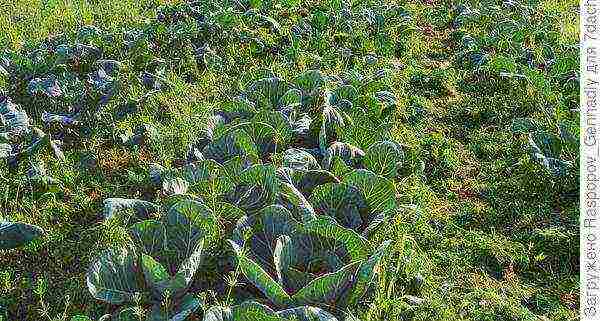
Cabbage
... and results
When I switched to such zero tillage technology, I was amazed at the results.
In the first years, he transported peat and manure to the field by machines, plowed under the plow, but the land became poorer, the hoe did not take it in the drought, the plants suffered. Now there are moles and earthworms everywhere, the soil after a rain is airy, structural. Weeds grow to the height of a person, the harvests of cabbage and potatoes without irrigation set records every year. On any cold summer in August, children eat corn, melons and watermelons grown without any film. This is in the north, at the latitude of Vologda.
At the end of July, we dig early potatoes:
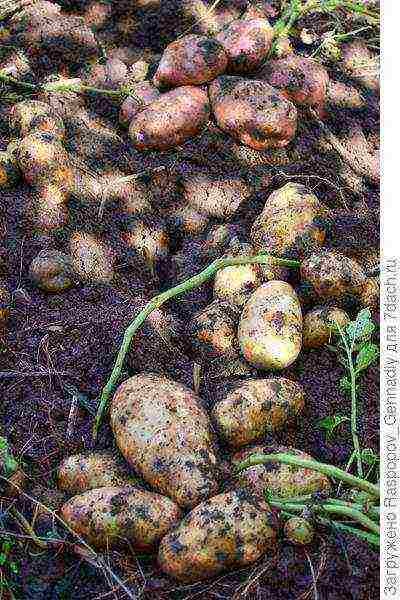
Early potatoes So that create living soil over a large area of the field, necessary:
- flat cutter,
- motor cultivator,
- very little organic
- trimmed weeds and left in the aisles.
And most importantly - every 1-2 weeks it costs to cultivate all the land and plants of ACC... And in spring and autumn - spray with humates. I add Agrovit-Kor to the soil.
Main harvest in September:
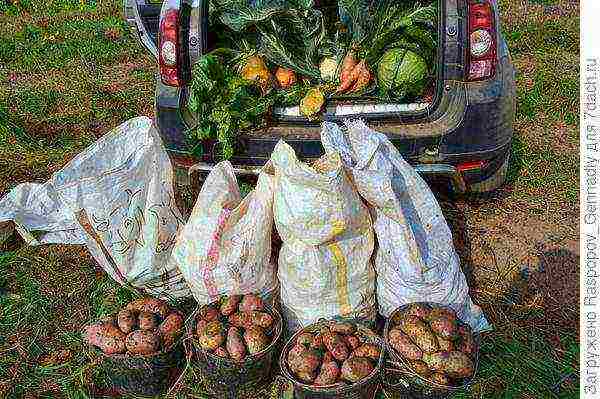
September
It turns out that in order to gather a family of 11 people all year round at one table and feed them with products grown on living land from their garden, vegetable garden and field, you need to have 10 cats in the yard ...
The cats checked - the earth is warm; call grandchildren in the field

Cats Goats checked - the grass grows; it's time to take out the manure
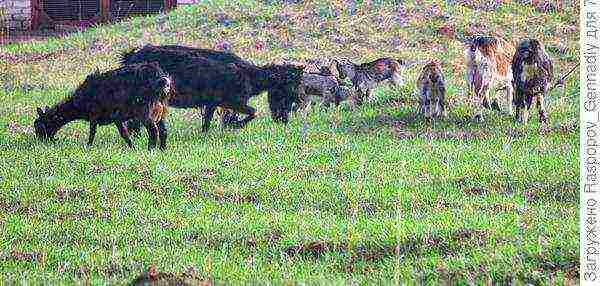
Goats
- Cats will scare off rats and mice - they will save grain and beets for animals.
- Animals will give a lot of manure, organic matter.
- Organic matter will feed the soil biota.
- Biota will make food healthier, rid the earth of pesticides and excess mineral water ...
Cats will teach grandchildren to love the earth and keep it healthy for future generations. And every year storks will fly to us
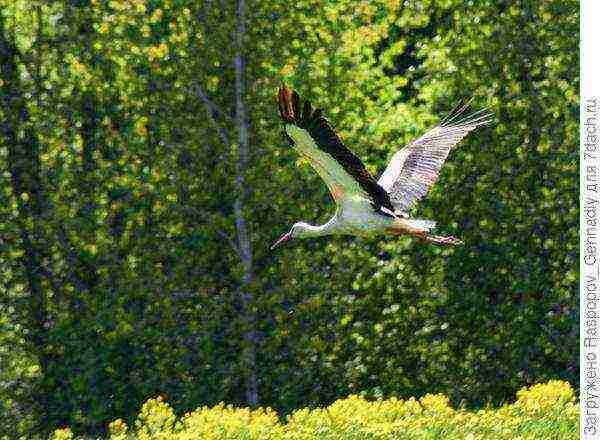
Storks will come to us every year
And in the winter, on duty, I will treat patients with my healing potatoes.

And in winter, on duty, I will treat patients with my healing potatoes Read also:
- Farming Without a Shovel, or My Experience of Creating Living Soil
- Secrets of mulching with organic materials
- How I make the right compost
- How to apply manure in an ecological garden. Secrets from the doctor
- What is Aerated Compost Tea (ACC)
- Earthworms, California worms: are they needed in our beds?
- Fokin's plane cutter: what it is and how to use it
- Weed roundup
